This collection, curated through public acclaim, showcases the unparalleled beauty and drama of the natural world, from the majestic and monumental to the small and seemingly insignificant.
Wildlife Photographer Of The Year 59 People’s Choice Winner: “Ice Bed” By Nima Sarikhani
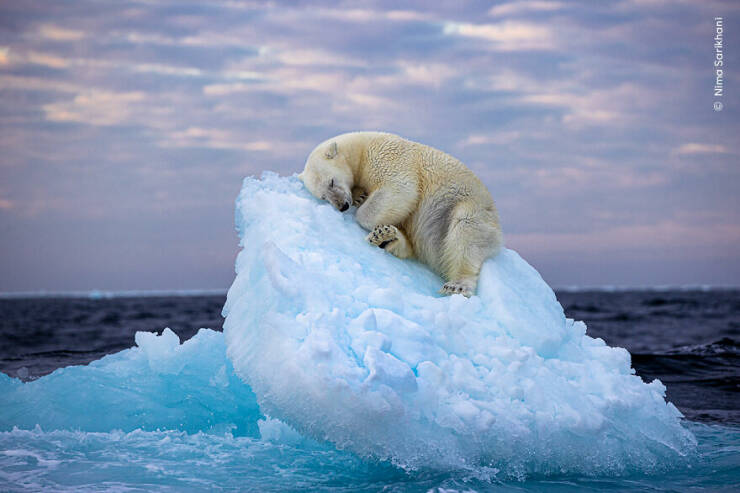
“A polar bear carves out a bed from a small iceberg before drifting off to sleep in the far north, in Norway’s Svalbard archipelago. Having spent three days searching for polar bears through thick fog, the expedition vessel Nima was on changed course. It turned and headed to where there was still some sea ice. Here Nima encountered a younger and an older male polar bear. Just before midnight, the young male clambered onto a small iceberg and, using its strong paws, clawed away to carve out a bed before drifting off to sleep.”
“The Happy Turtle” By Tzahi Finkelstein
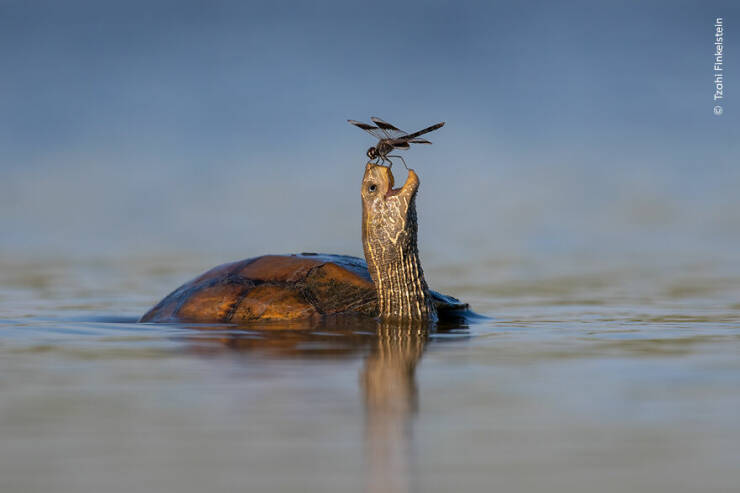
“A Balkan pond turtle shares a moment of peaceful coexistence with a northern banded groundling dragonfly in Israel’s Jezreel Valley.
Tzahi was positioned in his hide photographing shore birds when he spotted a Balkan pond turtle walking in the shallow water. At first, he wasn’t interested in it and carried on watching the birds. It wasn’t until a northern banded groundling dragonfly flew past his lens in the direction of the turtle that his focus changed. The dragonfly unexpectedly landed on the turtle’s nose, but instead of snapping up the insect, the turtle appeared to be experiencing pleasure from the interaction as they shared a moment in the midst of the swamp’s murky waters.”
“Snowshoes” By Deena Sveinsson
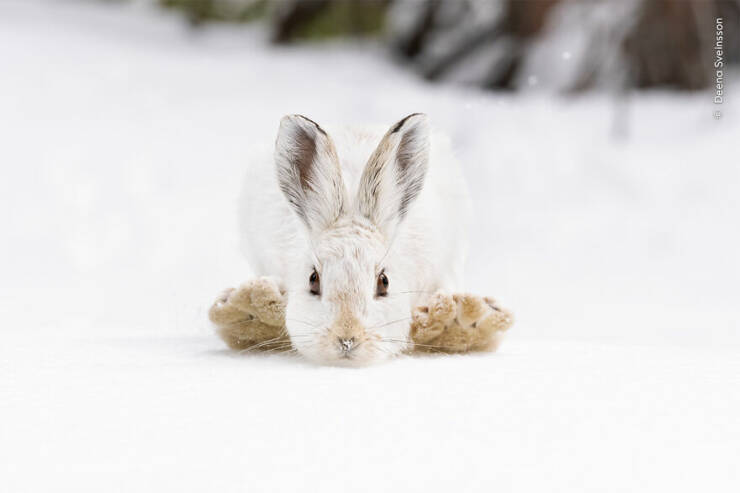
“It was a late spring morning and Deena was snowshoeing deep in the forests of the Rocky Mountain National Park, USA, when she noticed this snowshoe hare sleeping on a small snow mound.
Trying to be as quiet as possible, she positioned herself in front of it. Hours later the hare woke and hopped off the snow mound in Deena’s direction. Using a high frame rate, she captured the exact moment in its hop where the hare pulled its large back feet up next to its head. Its large feet prevent the hare from sinking into the deep, soft snow, acting like snowshoes hence its name the snowshoe hare.”
“Swallow Over Meadow” By Hermann Hirsch And Jan Lessman
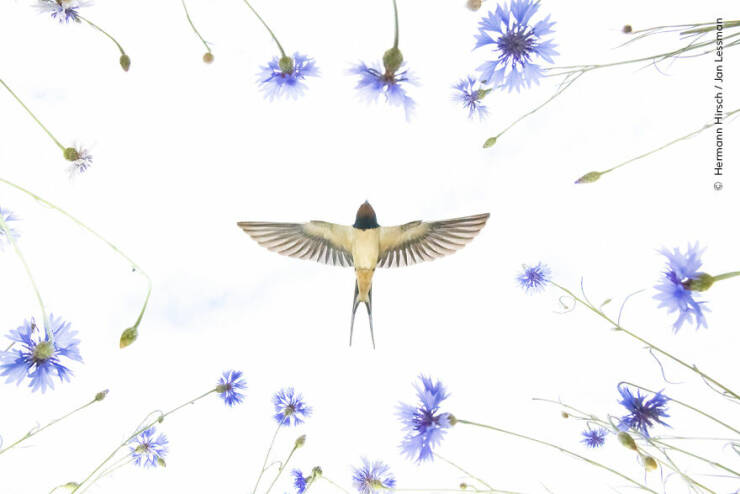
“A barn swallow flies over a meadow of cornflowers, catching insects during springtime in eastern Germany.
As their name suggests, barn swallows prefer to nest inside buildings, and usually return to the same spot each year, repairing nesting cups sculpted from mud and clay. Positioning their camera among the cornflowers, Hermann and Jan watched as the swallows continuously flew low over the meadow, catching insects on the wing. Using a remote control, they took this beautiful picture as one of the swallows flew over the camera.”
“Looking At Me, Looking At You” By John E. Marriott
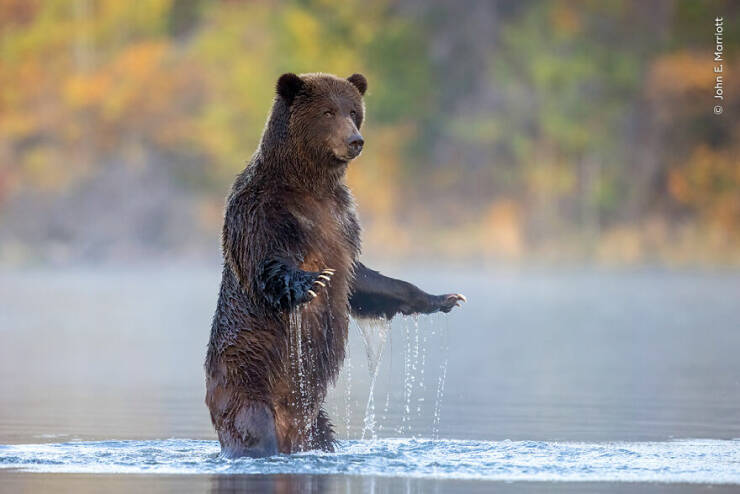
“John was leading a grizzly bear photography tour on the Chilko River when the group came across this bear salmon fishing.
Allowing the current to take their small boat slowly past the bear, they watched it rise up on its hind legs as if to get a better perspective on the salmon in the shallow water. As the bear was standing there, it momentarily glanced in the boat’s direction with a quizzical expression before returning to its salmon-fishing endeavors.”
“Starling Murmuration” By Daniel Dencescu
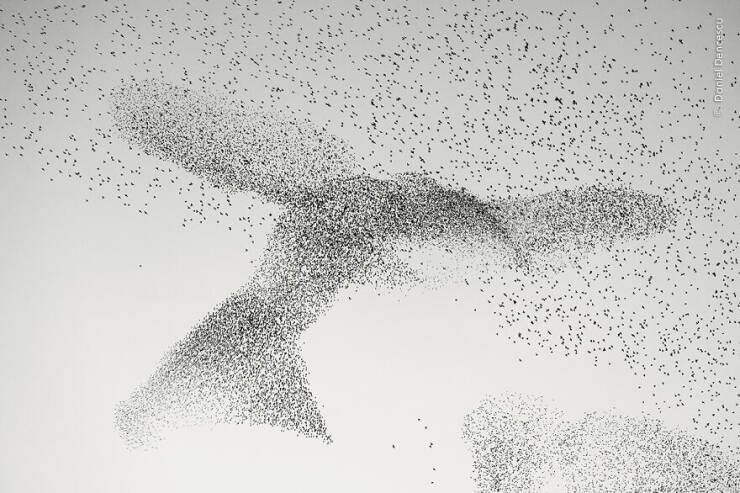
“Daniel was mesmerized by the movements of the starlings as they formed colossal organic shapes in the sky.
Each day, as they returned from foraging, they would gather in large numbers and perform spellbinding aerial shows, known as murmurations, on their flight home to their communal roosts. In a bid to locate the best roosting sites at which to capture the spectacle, Daniel spent hours following the starlings around the city and suburbs of Rome. Finally, on this cloudless winter’s day, the flock didn’t disappoint, swirling into the shape of a giant bird.”
“Aurora Jellies” By Audun Rikardsen
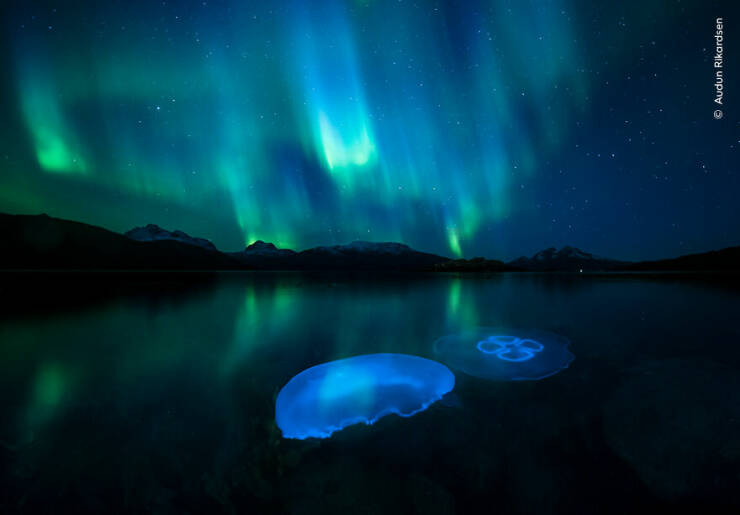
“Moon jellyfish swarm in the cool autumnal waters of a fjord outside Tromsø in northern Norway illuminated by the aurora borealis.
Sheltering his equipment in a self-made waterproof housing, Audun used a single exposure as well as his own system for adjusting the focus and aperture during the exposure. This enabled him to capture the reflection of the sky’s colors on the surface of the water and at the same time light up the jellyfish with flashes. Moon jellyfish are common in all oceans and are easily recognized by their four rings, which are in fact their genitals.”
“Curiosity” By Gerald Hinde
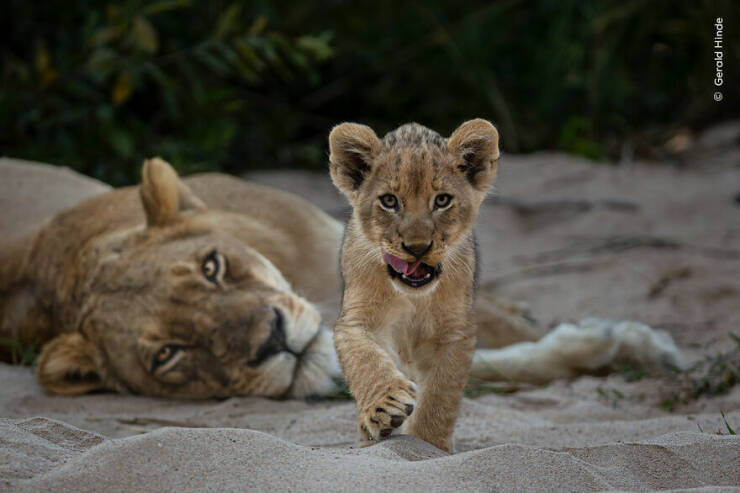
“Under the watchful eye of its mother in South Africa’s Greater Kruger National Park, a curious lion cub walks towards the photographer, who was watching from a vehicle.
Gerald had parked his vehicle in the riverbed. This was the first cub to come and investigate his arrival. Holding his camera out of the vehicle, close to the ground, he managed to get a low photographic angle of the cub’s activities. Lion cubs are vulnerable to other predators such as leopards and hyenas, but often the main threat is from invading male lions. For the first six weeks they’re kept hidden away, after this they’re introduced to the pride and protection is provided by all the members.”
“Neighbourhood” Dispute By Ofer Levy
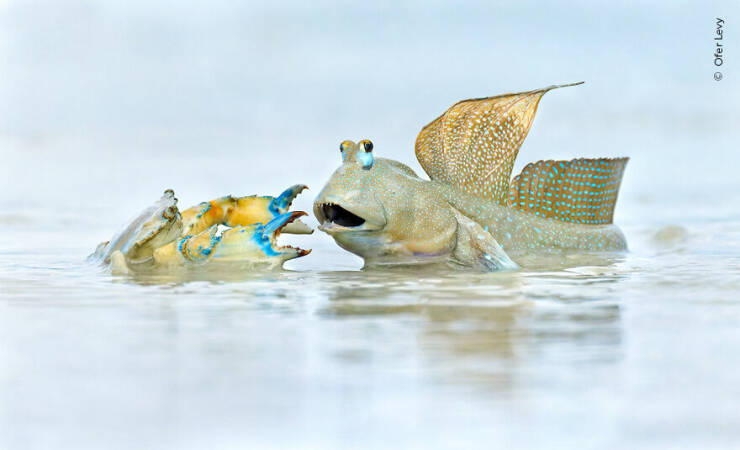
“A mudskipper fiercely defends its territory from a trespassing crab in Roebuck Bay, Australia.
Mudskippers are extremely territorial, often building mud walls around their territories where they feed and breed. This crab is evidently trespassing and by opening its mouth and raising its dorsal fin, the mudskipper is challenging the intruder, attempting to scare it off with a threatening display. Ofer watched the two continually confront each other out on the mud flat – the mudskipper always initiating the clash.”
“Homecoming” By Dvir Barkay
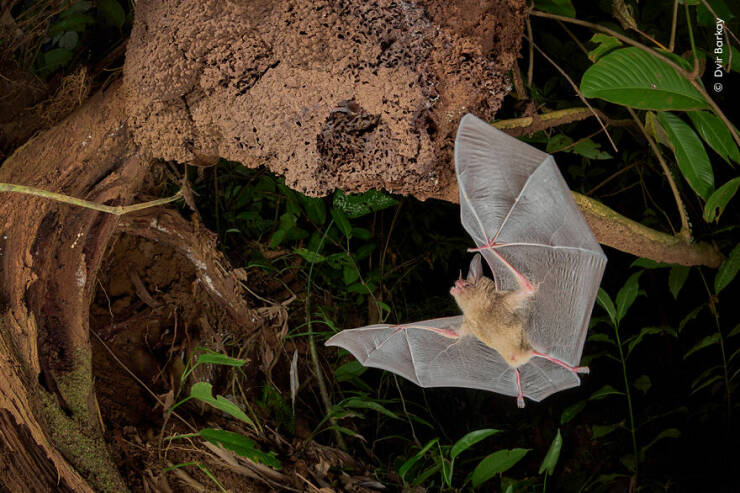
“Dvir spent more than two months attempting to get images of the rarely photographed pygmy round-eared bat in the lowland rainforests of Costa Rica.
The bats exhibit a unique roosting behavior, resting in hollows that they carve out with their teeth inside the nests of termite colonies. Using a nearby branch to support his camera, Dvir set up an infrared trigger near the entrance of the roost, together with three diffused flashes. This image shows one of the bats returning home as two well-camouflaged family members peer out from the entrance.”
“Shared Parenting” By Mark Boyd
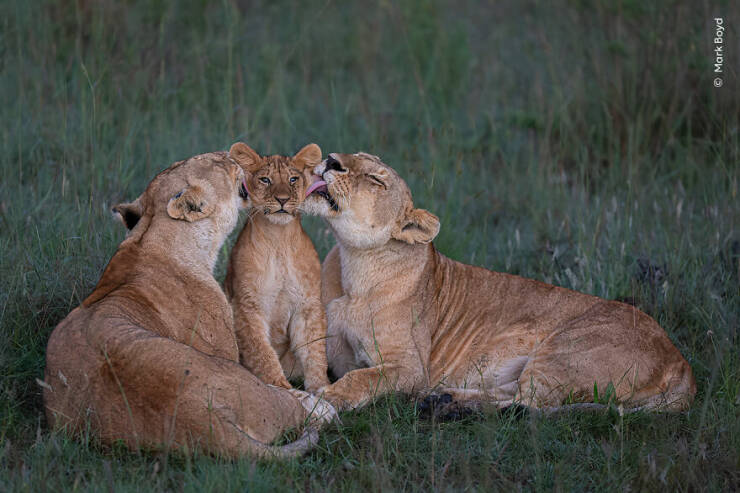
“Early in the morning, Mark watched as these lionesses groomed one of the pride’s five cubs in Kenya’s Maasai Mara.
They had set off to hunt the evening before, leaving the cubs hidden overnight in dense bushes. Returning from their unsuccessful mission, they’d called the cubs out onto the open grassland. Females raise each other’s cubs as their own, sharing parenting duties. Here the youngster was clearly enjoying the moment of affection and attention.”
“Tender Touch” By Andy Parkinson
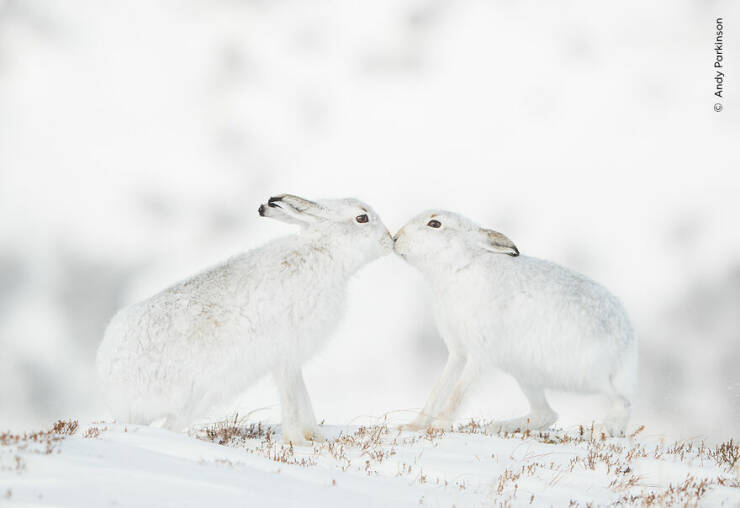
“For 15 years Andy’s been photographing the hares of Scotland’s Monadhliath Mountains, but in all that time he’s never witnessed a moment like this.
He was expecting the female to repel the male’s advances with the usual explosive boxing behavior, so included lots of space around them. Unexpectedly, the two courting hares came together and touched noses. Acting quickly, Andy caught their special moment on camera. For him, this was yet more evidence of the highly complex social relationships that animals have with one another.”
“Autumn Glow” By Uge Fuertes Sanz
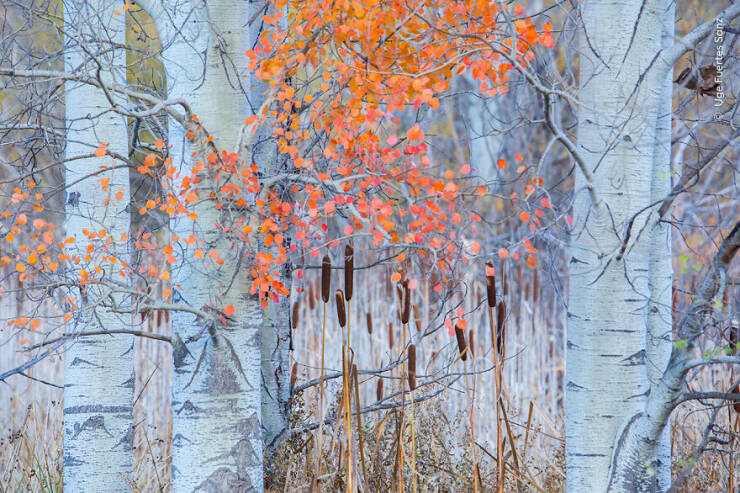
“To Uge, this small corner of the river, among the bulrushes and quaking aspens, seemed as if it had been painted.
The light and the composition of the plants between the trunks, together with the shapes and colors of the autumn leaves, created texture and balance. He took more than a hundred images while on the banks of the River Cabriel in the Sierra de Albarracin Mountains, Spain, waiting patiently for a cloud to pass overhead so a soft light would wash over everything.”
“The Grassland Geladas” By Marco Gaiotti
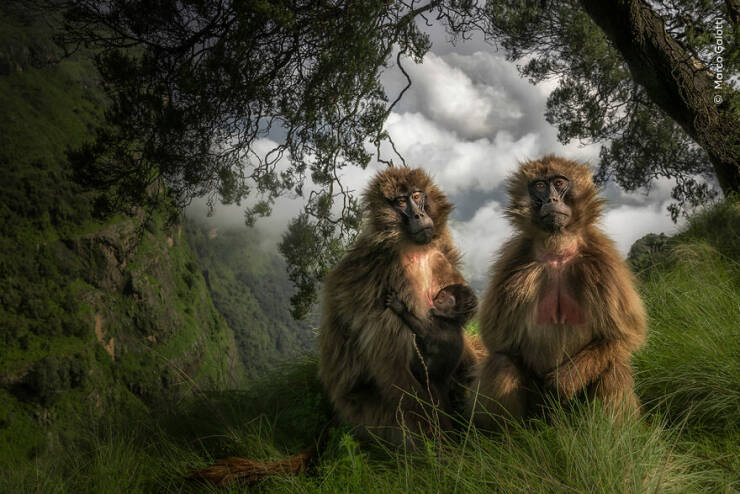
“Taken during the August rainy season, with looming clouds threatening a downpour, a gelada suckles its baby alongside a companion at the edge of a plateau in the Simien Mountains of Ethiopia.
The gelada family unit, known as a harem, usually consists of one male and a small number of related females and their young. Gelada monkeys live only in the high mountain meadows of Ethiopia, where they spend most of their time on the ground grazing. However, with numbers of domestic livestock increasing, their grazing grasslands are now diminishing, pushing them into restricted areas.”
“Missed Sip Of Milk” By Karim Iliya
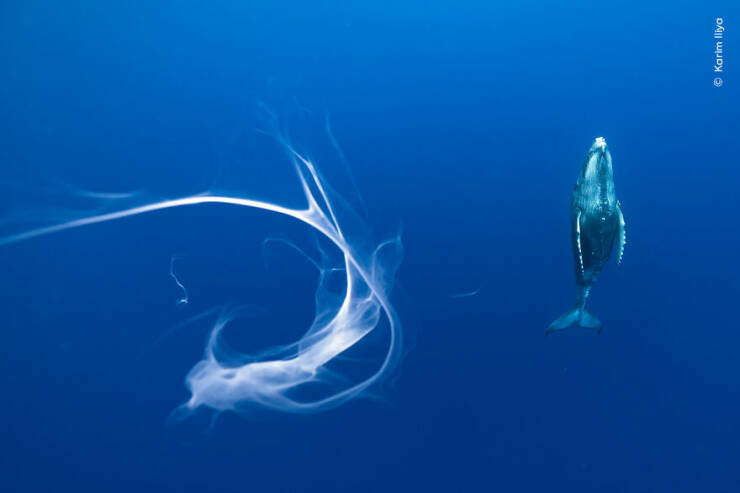
“A humpback whale calf misses some of its mother’s milk, which drifts and swirls in the currents off the coast of Rurutu, French Polynesia.
In the seven years and hundreds of hours Karim’s been documenting humpback whales, he’s only seen whale milk floating in the water twice. Both times were on a diving trip off the coast of Rurutu, with the same whale and her calf. Humpback whales don’t have lips, so the calves can be clumsy and on very rare occasions miss some of the milk. Just as Karim was preparing to go back up to the surface, he saw the calf rising in the background and captured these strands of milk drifting and swirling in the current.”
“A Rare Sight” By Axel Gomille
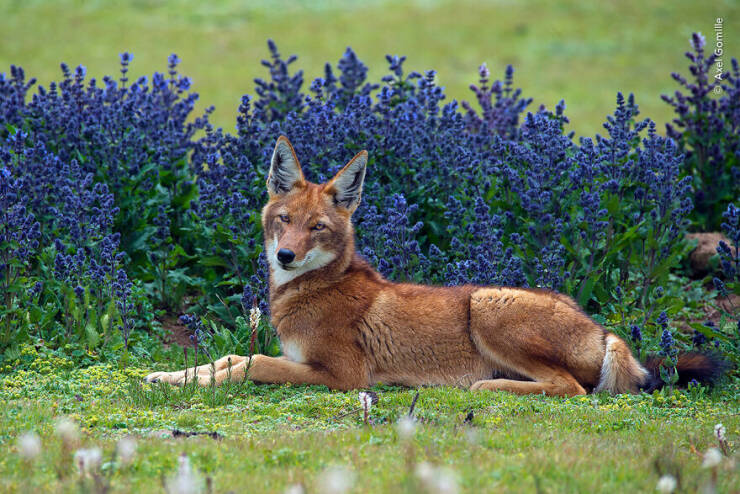
“The summer greens and blues provide the perfect backdrop for the chestnut tones of the Ethiopian wolf’s coat in this serene image.
One of the rarest species of wild dogs in the world, it is estimated that there are only a few hundred left, surviving in the low-growing, Afro-alpine shrubland of the highlands of Ethiopia. The Bale Mountains National Park, where this image was taken, supports the largest population of Ethiopian wolves. They’re threatened by habitat loss and diseases, such as rabies and canine distemper, which they catch from domestic dogs.”
“Tough Negotiation” By Ayala Fishaimer
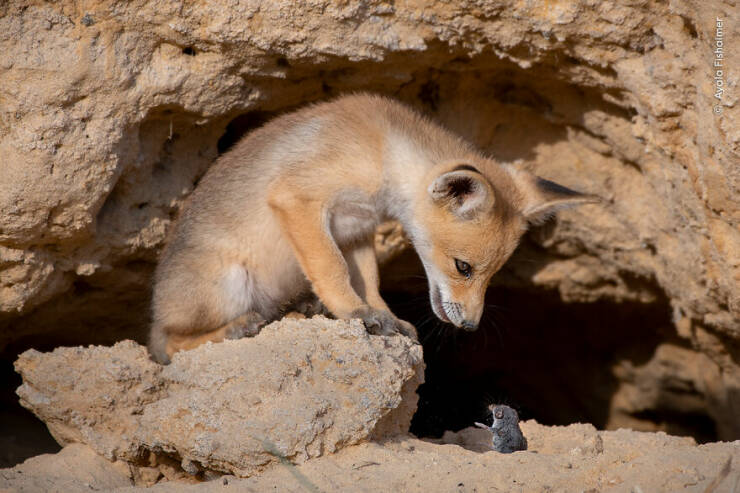
“Standing on a rock in the Judean Foothills of Israel, a red fox cub locks eyes with the shrew it had thrown up in the air moments earlier.
After an hour of driving, Ayala arrived at the red fox den and, parking a safe distance away waited. It wasn’t long before four cubs appeared and started to play. This cub lost interest in its siblings and started sniffing around. Moments later, it pulled a shrew out of the sand and started knocking it around like a ball. Then, standing on a rock, the cub threw the shrew in the air. As it landed, Ayala caught the moment the hapless shrew and the fox locked eyes.”
“Troublemaker” By Stefan Christmann
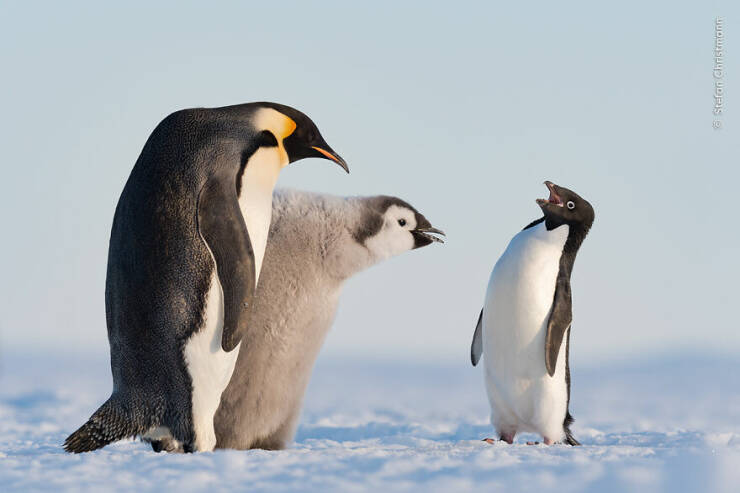
“An Adélie penguin approaches an emperor penguin and its chick during feeding time in Antarctica’s Atka Bay.
Stefan watched intently to see how the interactions between these three penguins would play out. Adélie penguins only appear in Antarctica’s Atka Bay for a short period during the southern hemisphere summer. They’re opportunists and can be a nuisance for emperor penguins and their chicks. If the chance arises, Adélie penguins will try to cause the adult or the chick to drop its food while the chick is being fed, snatching any that falls to the ground.”
“Opportunity Fox” By Matt Maran
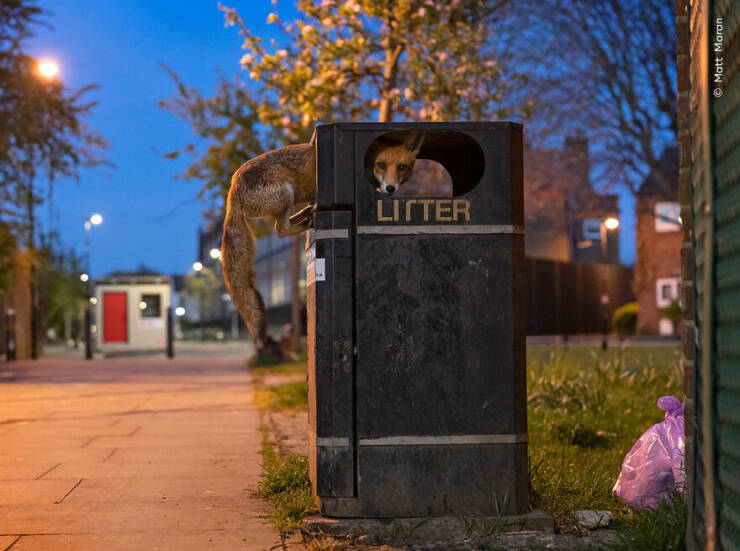
“Over a two-month period Matt watched a young male red fox learn the best time to climb into this street bin in London.
It figured out it was Monday evenings, shortly before the weekly collection, when the rubbish was piled high and any discarded food that rested on top was easy to get at. Contrary to what most people think, an urban fox’s diet is made up of more than 50% natural food, such as earthworms, wild birds, seeds and fruits. As a result, these animals play an important role in the urban ecosystem.”
“Duckling Huddle” By Charles Davis
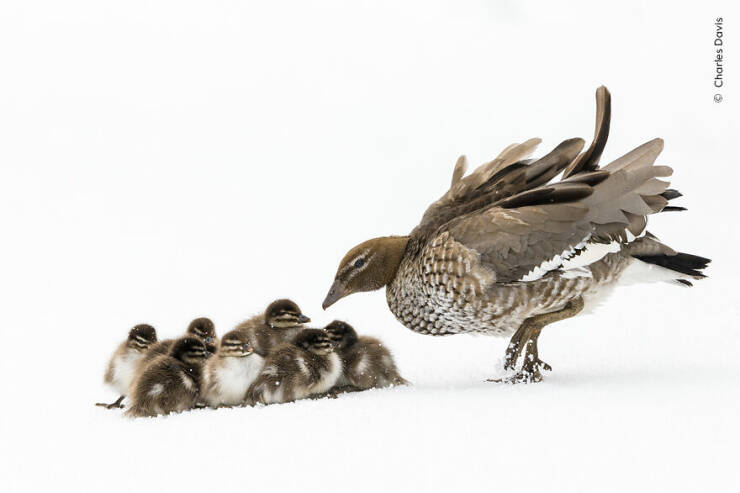
“A wood duck and its brood are caught in a late spring snowstorm in Smiggin Holes, New South Wales, Australia.
It would normally be warm and sunny when these ducklings hatch from their nest high up in a tree hollow, but thanks to the La Niña effect things were a bit different this year. Warmer waters in the western Pacific meant more precipitation, resulting in more rain than normal in eastern Australia and cooler and wetter springs and summers. Despite the conditions, the ducklings chose to exit their nest, dropping down into a frozen world. Upon landing, they quickly became lost in a snowstorm as their mother tried to lead them to open water.”
“Bull In A Garbage Dump” By Brent Stirton
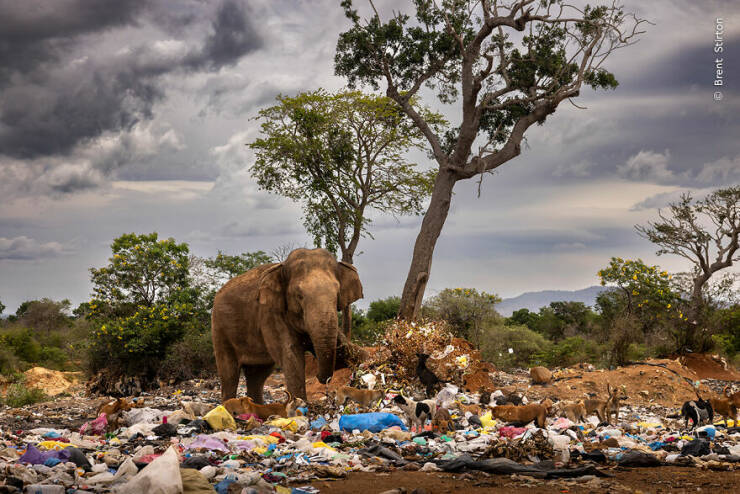
“A bull elephant kicks over garbage as it scavenges for rotten vegetables and fruit at a dump in Tissamaharama, Sri Lanka.
A number of elephants are attracted to this location not only by the rubbish but also by nearby crops. The scar from a gunshot wound on the upper part of this elephant’s left front leg and another wound high on its back indicate it’s an insistent crop raider. Human-elephant conflict often escalates from shouting to frighten the elephants away from crops and people to firing warning shots. The shots are seldom fatal but only deter the elephants for a couple of months at a time.”
“Incoming Cuckoo Wasp” By Frank Deschandol
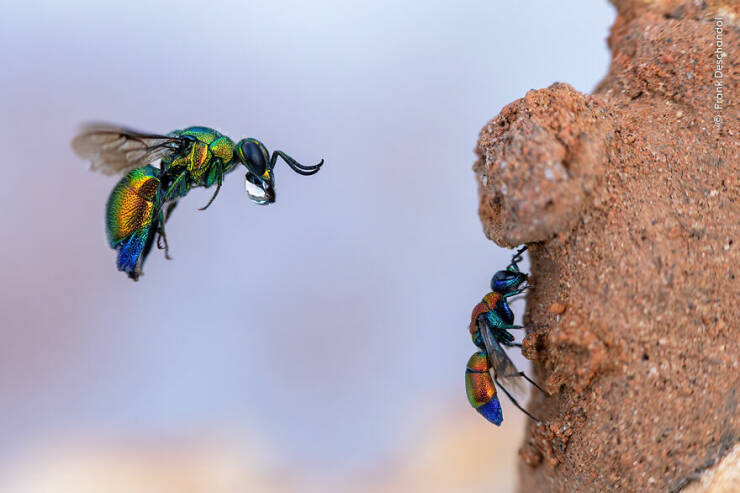
“Near Montpellier, France, a cuckoo wasp is captured mid-air trying to enter a mason bee’s clay burrow as a smaller cuckoo wasp cleans its wings below.
Frank set up near the mason bee’s burrow hoping to photograph the rare cuckoo wasp that parasitises these bees. He was in luck, when not one but two cuckoo wasps appeared. While Frank was taking some shots, the larger cuckoo wasp flew off, returning seconds later with a drop of water at its mouth. The wasp uses water and saliva to soften the clay so it can dig into the bee’s sealed-up burrow. Once inside it lays its own egg, then closes the burrow up again. When the cuckoo wasp’s egg hatches, it feeds on mason bee larvae inside the burrow.”
“Rubbish Drinks” By Claire Waring
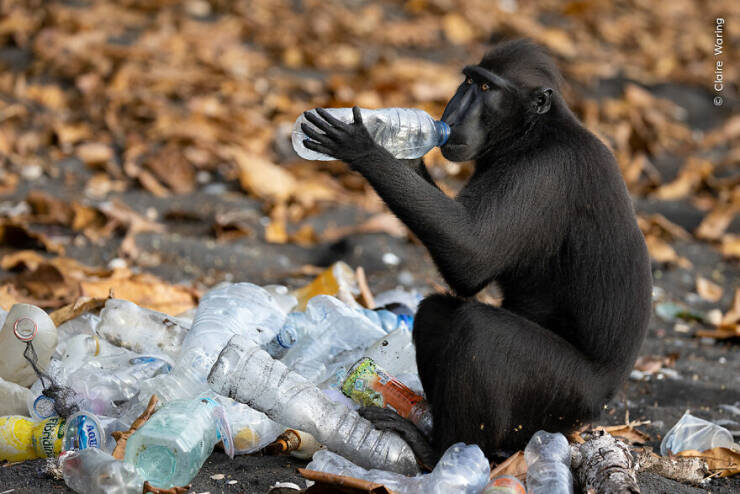
“A Celebes crested macaque investigates the contents of a plastic bottle from a pile ready for recycling on a beach at the edge of Tangkoko Batuangus Nature Reserve, Indonesia.
Most of them had washed up from the sea, and despite the sizeable pile, more would soon be added. The Celebes crested macaques have learnt that these bottles contain liquid and are often seen chewing off the caps to reach the contents. They’ve also worked out that the coloured bottles are more likely to contain sweet liquid and so pick these. Some even carried bottles away into the forest, frustrating the rangers’ efforts.”
“Fashion Victims” By Britta Jaschinski
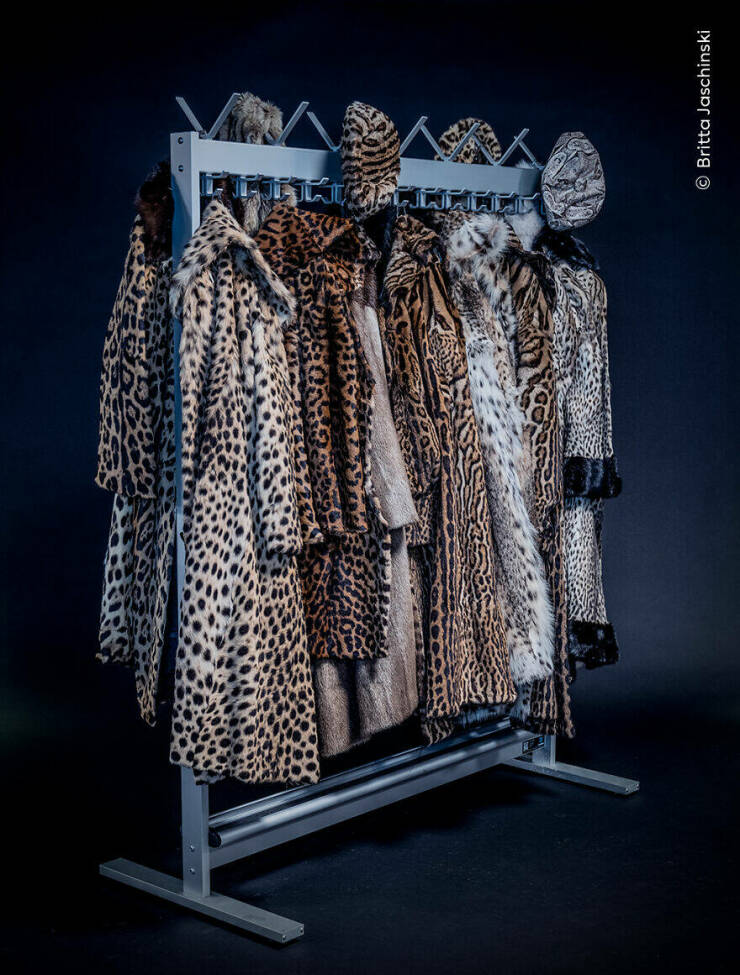
“A rack of coats made from the skins of some of the most endangered big cats on Earth, including snow leopard, jaguar and ocelot, is displayed.
Confiscated by customs officers across Europe, the coats were held in Hamburg’s Leibniz Institute for the Analysis of Biodiversity Change for forensic tests before being used at educational events to ensure they never return to the black market. During the photoshoot, Britta learnt that on average the fur industry uses 12 animals to make one coat. Together with a biologist, she tried to identify how many cats were killed to produce the fashion items in this image, but they stopped counting, as it was just too shocking.”
“Hope” By Roberto García-Roa
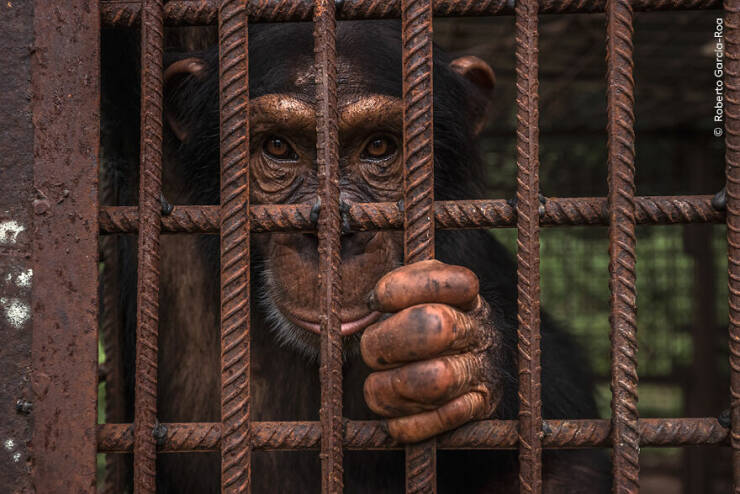
“While photographing rescued chimpanzees at the Chimpanzee Conservation Center in the Republic of Guinea, Roberto captured this pensive portrait.
Located in the National Park of Upper Niger, the center houses orphaned chimpanzees that have been rescued from being sold as pets after their mothers were killed for bushmeat. Once abundant in Guinea, the western chimpanzee population is declining, and the species is now classified as Critically Endangered. The center rehabilitates the chimpanzees with the aim of releasing them back into the national park. It also works with local communities to show them why it’s important to protect the rainforest and its inhabitants.”
Source: www.facebook.com
 Barnorama All Fun In The Barn
Barnorama All Fun In The Barn